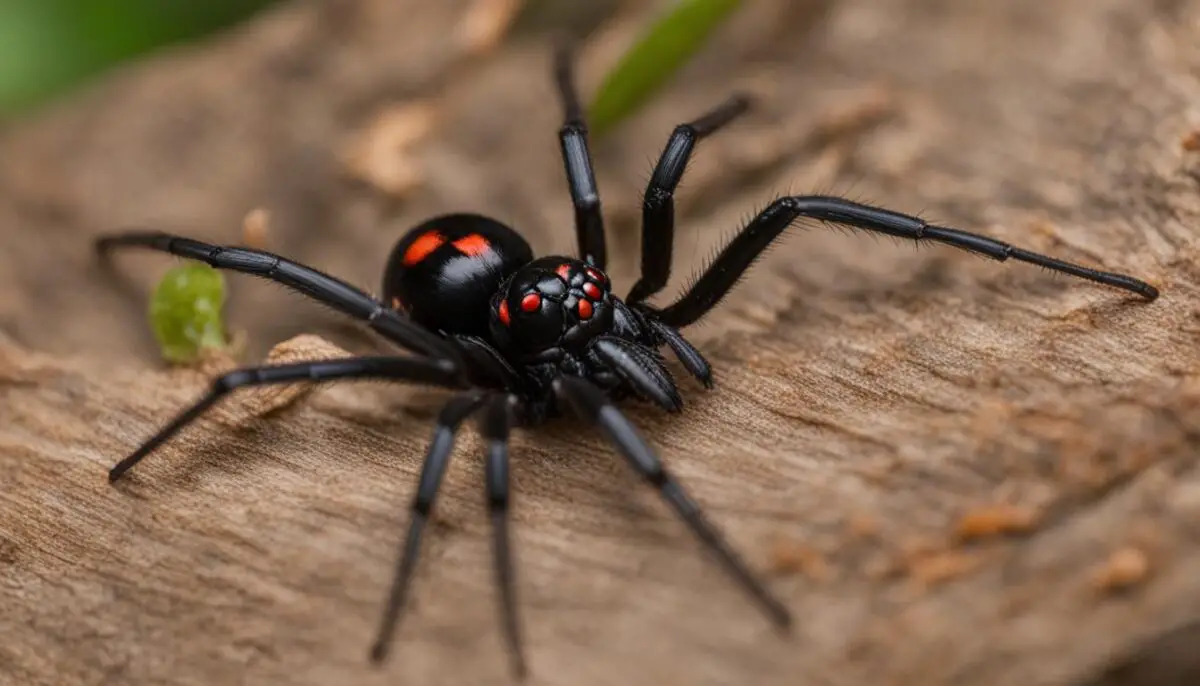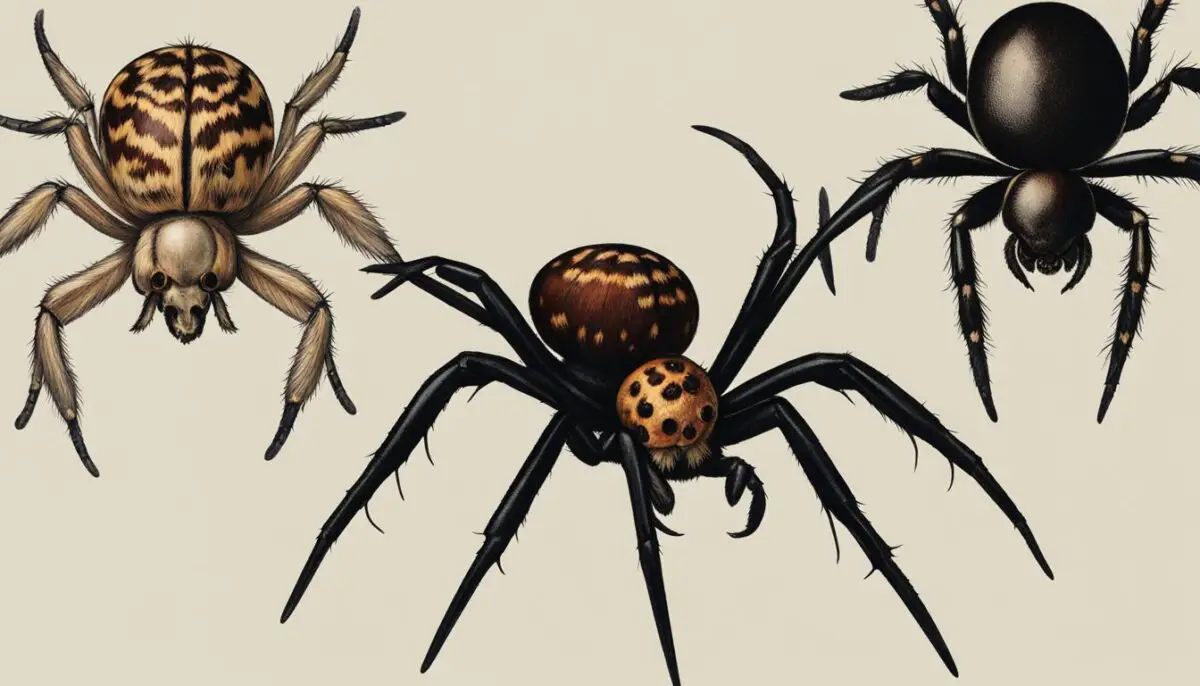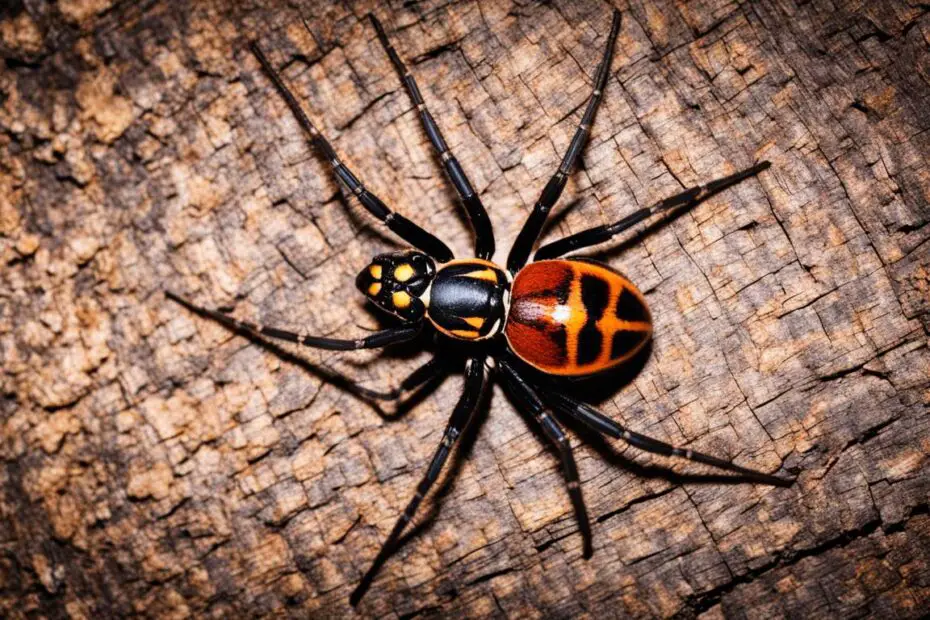False widow spiders can cause concern for those who come across them, especially when they are mistaken for other spider species. It’s important to be able to identify these look-alikes and tell them apart from the true false widow spider. In this article, we will provide a guide to help you distinguish false widow spider look-alikes from the real deal.
Key Takeaways:
- False widow spider look-alikes can be mistaken for other spider species.
- Identifying false widow spider look-alikes is crucial to avoid unnecessary concern.
- This guide will help you differentiate between false widow spider look-alikes and the true false widow spider.
- Understanding the characteristics and markings of different spider species is key to accurate identification.
- Consider factors such as size, coloration, markings, and web patterns when identifying spiders.
Common False Widow Spider Species in the UK
In the UK, there are several species of false widow spiders that resemble the true false widow spider. These include the noble false widow, cupboard spider, and rabbit hutch spider. Each species has distinct characteristics that can help differentiate them from other spiders.
False Widow Spider Look-Alikes:
- The noble false widow: This species has a skull-shaped or pentagon-shaped pattern on its abdomen, making it easily identifiable. It is usually brown or dark brown in color and has a shiny appearance.
- The cupboard spider: With two clear triangles and lateral bars on its abdomen, the cupboard spider has unique markings that set it apart from other spiders. Its color can vary from light brown to dark brown.
- The rabbit hutch spider: This species has a distinct pattern on its abdomen, resembling a rabbit hutch. It is typically brown or black and has a smooth texture on its body.
By familiarizing yourself with these different species, you can better identify false widow spider look-alikes and distinguish them from the true false widow spider.
| False Widow Spider Species | Distinct Characteristics |
|---|---|
| The noble false widow | Skull-shaped or pentagon-shaped pattern on abdomen |
| The cupboard spider | Two clear triangles and lateral bars on abdomen |
| The rabbit hutch spider | Distinct pattern resembling a rabbit hutch on abdomen |

Additional Tips for Identifying False Widow Spider Look-Alikes:
- Pay attention to the size and coloration of the spider.
- Observe the patterns and markings on the spider’s abdomen.
- Take note of any other unique characteristics, such as the texture of the spider’s body.
By using this spider identification guide, you can confidently distinguish false widow spider look-alikes from the true false widow spider and alleviate any concerns.
True Black Widow Spider Species in the United States
In the United States, true black widow spiders belong to the genus Latrodectus. The most common species found in the country include the southern black widow, northern black widow, and western black widow. These spiders often get mistaken for false widow spider look-alikes due to their similar appearance. However, there are distinct characteristics that can help you differentiate true black widow spiders from their counterparts.
One key characteristic of true black widow spiders is their glossy-jet black coloration. This distinguishing feature sets them apart from other spider species. Additionally, true black widow spiders have a unique marking on the underside of their abdomen – a red or orange hourglass shape. This hourglass pattern is a clear identifier of the true black widow spider.
Understanding these characteristics and markings is crucial for spider identification. By recognizing the glossy-jet black coloration and the red or orange hourglass shape, you can confidently differentiate true black widow spiders from false widow spider look-alikes.
To further illustrate the identifying features of true black widow spiders, refer to the table below:

Comparative Characteristics of True Black Widow Spider Species
| Species | Coloration | Abdomen Markings |
|---|---|---|
| Southern Black Widow | Glossy-jet black | Red or orange hourglass shape |
| Northern Black Widow | Glossy-jet black | Red or orange hourglass shape |
| Western Black Widow | Glossy-jet black | Red or orange hourglass shape |
By referring to this table and recognizing the distinct coloration and abdomen markings, you can effectively compare and identify true black widow spider species.
Brown Widow Spider and Red Widow Spider
When it comes to false widow spider look-alikes, two species that often cause confusion are the brown widow spider and the red widow spider. Both of these spiders share similarities in appearance, making it essential to pay attention to specific details in order to accurately identify them.
Young brown widow spiders and western black widows can look quite similar. However, there are distinguishing markings that set them apart. For adult female brown widow spiders, a reddish hourglass marking can be found on the bottom of their abdomen. On the other hand, adult female red widow spiders display a reddish-orange coloration with rows of red or orange spots on the top of their abdomen.
By focusing on these distinct characteristics, you can effectively differentiate between brown widow spiders and red widow spiders, ensuring accurate spider identification.

Brown Widow Spider Characteristics
| Species | Markings | Coloration |
|---|---|---|
| Brown Widow Spider | Reddish hourglass marking on the bottom of the abdomen | Variations of brown and tan |
Red Widow Spider Characteristics
| Species | Markings | Coloration |
|---|---|---|
| Red Widow Spider | Rows of red or orange spots on the top of the abdomen | Reddish-orange |
Remember to observe these unique characteristics carefully when encountering spiders that resemble false widow spiders. This will enable you to correctly identify whether you are dealing with a brown widow spider or a red widow spider, ensuring your peace of mind.
Other Spiders Mistaken for False Widow Spiders
In addition to the true black widow spiders and other species mentioned earlier, there are other spiders that can be mistaken for false widow spiders. Two common examples are the missing sector orb weaver and the lace webbed spider. These spiders are harmless to humans and have different characteristics from false widow spiders. By learning about these other spider species, you can avoid confusion and accurately identify false widow spider look-alikes.
Missing Sector Orb Weaver
The missing sector orb weaver (Zygiella x-notata) is a common spider species that resembles false widow spiders. Also known as the missing sector spider or silver-sided sector spider, this harmless spider is often found in houses, garages, and sheds. The missing sector orb weaver has a slightly rounded abdomen with a cream-colored pattern on the upper side and silver chelicerae. Unlike false widow spiders, it does not possess the distinct markings or dark coloration.
Lace Webbed Spider
The lace webbed spider (Amaurobius similis) is another spider species that can be mistaken for false widow spiders. Found in gardens, sheds, and under stones, the lace webbed spider is harmless to humans. It has a reddish-brown color, with a small, rounded abdomen and long legs. Unlike false widow spiders, the lace webbed spider does not have the characteristic markings or hourglass shape on the abdomen.
“Understanding the differences between these spider species is crucial for accurate spider identification. Mistaking harmless spiders for false widow spiders can lead to unnecessary concerns and interventions.”

By familiarizing yourself with the missing sector orb weaver, lace webbed spider, and other spider species mentioned in this article, you can confidently identify false widow spider look-alikes and distinguish them from the true false widow spiders. Remember to consider factors like size, coloration, markings, and web patterns when identifying spiders.
Domestic House Spiders and Black House Spiders
When it comes to identifying false widow spider look-alikes, domestic house spiders and black house spiders are two species that can often cause confusion. Let’s take a closer look at their characteristics to help you differentiate them.
Domestic House Spiders
Domestic house spiders, also known as barn funnel weaver spiders, share some similarities with false widow spiders. However, there are key differences that can help you distinguish them. Domestic house spiders typically have a reddish-brown coloration and a pale, freckled abdomen. Their bodies are slender and elongated, and they construct intricate funnel-shaped webs in corners or crevices.
Black House Spiders
In contrast, black house spiders have a bulkier and more awkward appearance compared to false widow spiders. Their legs are dark brown, and their abdomen is typically gray. These spiders can often be found in dark and secluded areas such as sheds, garages, or under rocks. While their presence may cause concern, black house spiders are not venomous and are generally harmless to humans.
By paying attention to these distinct characteristics, you can confidently differentiate domestic house spiders and black house spiders from false widow spider look-alikes.
Comparison of Domestic House Spiders and Black House Spiders
| Characteristic | Domestic House Spiders | Black House Spiders |
|---|---|---|
| Color | Reddish-brown | Dark brown legs, gray abdomen |
| Abdomen | Pale with freckles | Gray |
| Body shape | Slender and elongated | Bulkier and more awkward |
| Web structure | Intricate funnel-shaped webs | N/A (Not known for elaborate web construction) |
As seen in the table, there are notable differences in color, abdomen appearance, body shape, and web structure between domestic house spiders and black house spiders. These distinctions will help you accurately identify these spider species and avoid any confusion with false widow spider look-alikes.
Conclusion
Identifying false widow spider look-alikes can be a challenge, but with the right knowledge and attention to detail, you can confidently differentiate them from the true false widow spider. By understanding the unique characteristics and markings of different spider species, you can avoid unnecessary concern and accurately identify these spiders.
When identifying spiders, it’s important to consider various factors such as size, coloration, markings, and web patterns. By following this identification guide, you will be able to spot the subtle differences between false widow spider look-alikes and the real deal.
Remember, spider identification is crucial for creating a safe environment. By being aware of spider similarities and engaging in a spider species comparison, you can alleviate any fears and address spider-related issues appropriately. Stay informed and stay safe!
FAQ
Can false widow spiders be mistaken for other spider species?
Yes, false widow spiders can be mistaken for other spider species, causing concern for those who come across them.
What are the common false widow spider species in the UK?
The common false widow spider species in the UK include the noble false widow, cupboard spider, and rabbit hutch spider.
How can I distinguish false widow spider look-alikes in the UK?
By learning about the distinct characteristics of each species, such as the skull-shaped abdomen pattern of the noble false widow or the two clear triangles and lateral bars on the abdomen of the cupboard spider.
What are the true black widow spider species in the United States?
True black widow spider species in the United States include the southern black widow, northern black widow, and western black widow.
What are the distinctive markings of true black widow spiders?
True black widow spiders have a glossy-jet black coloration and a red or orange hourglass shape on the underside of the abdomen.
How can I differentiate brown widow spiders and red widow spiders from false widow spider look-alikes?
Adult female brown widow spiders have a reddish hourglass marking on the bottom of their abdomen, while adult female red widow spiders are reddish-orange with rows of red or orange spots on the top of their abdomen.
What are some other spiders that can be mistaken for false widow spiders?
Other spiders that can be mistaken for false widow spiders include the missing sector orb weaver and the lace webbed spider, both of which are harmless to humans and have different characteristics.
How can I differentiate domestic house spiders and black house spiders from false widow spider look-alikes?
Domestic house spiders have a reddish-brown color and a pale, freckled abdomen, while black house spiders are bulkier with dark brown legs and a gray abdomen.
How can I confidently identify false widow spider look-alikes?
By familiarizing yourself with the distinct characteristics and markings of different spider species.

